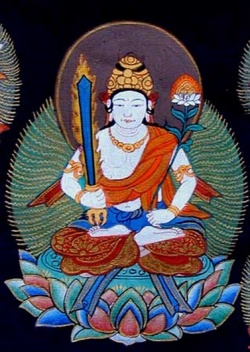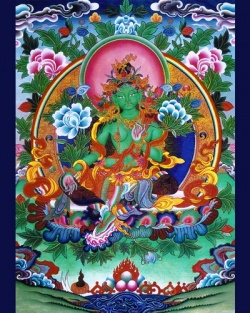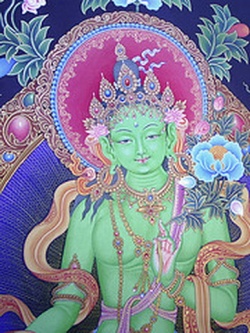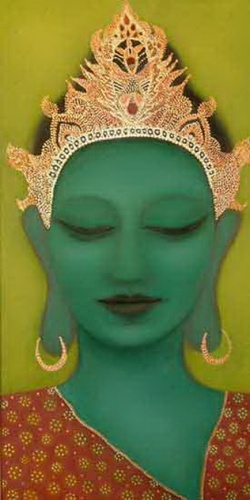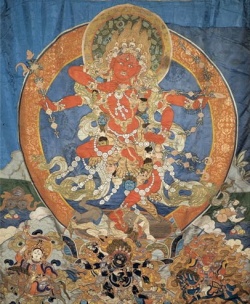Myth and Symbolism by Dr. Peter Della Santina
In Chapter 24 we talked about how the special characteristic of the Vajrayana is its use of the totality of experience to achieve direct or immediate Knowledge of nonduality. In turning the totality of experience to the use of this spiritual or religious endeavor, it is important that we select elements of experience that are specially powerful and meaningful. This does not exclude using the totality of our experience for our spiritual progress. Rather, it means that we focus first on types of experience that are particularly powerful and meaningful, using them as the building blocks of our transformed vision.
We then extend that transformed experience so that it eventually encompasses all experiences, even those that were originally less significant. Initially, then, we select elements of experience that are specially potent and powerful. In the process, certain archetypal elements are isolated. Archetypal elements of experience are those that have a very deep-seated mode of being within both an individual Consciousness and our collective Consciousness (that is, the sum total of all individual Consciousness).
Let us look at some specific examples of archetypal experience. The first belongs to the realm of myth. The most dominant feature of myth is the struggle between good and Evil. This is perhaps the primordial, fundamental mythological theme, and has been worked out in myths from the beginning of time up to the present day. For example, the crux of the contest between Rama and Ravana in the Ramayana is the struggle between the forces of good and the forces of Evil, and this continues to be a dominant theme in most popular myths. Not so long ago, we even saw the theme of the struggle between good and Evil mythologized in the popular science-fiction movie Star Wars.
We see this theme also in the attitudes and rhetoric of politicians and national leaders. For example, when U.S. President Ronald Reagan called the USSR 'the Evil Empire,' he was borrowing a phrase from Star Wars to indicate his conviction that the struggle between the democratic World and the communist World was one of good against Evil. This is a very important theme in human culture. When we call this theme a mythological one, it does not devalue it. If anything, this increases its value because it gives that theme a superhuman dimension, a universal significance. To call a theme mythological does not make it unreal--in fact, it makes it more so.
Good and Evil are, of course, a duality (like subject and object, self and other, Samsara and Nirvana, and the rest).The transcendence of the duality of good and Evil, the Mastery of and assimilation of Evil by good, is represented symbolically in the appearance of the deities of the Vajrayana pantheon. In Chapter 24, we talked about how we could transform elements of experience and put make use of them for our spiritual progress. What we have here is the Mastery of what we would normally think of as Evil by good--namely, the assimilation and transformation of the mythical totality of Evil in the Form of specific elements of the Vajrayana pantheon.
This explains the general appearance of the deities of the Vajrayana pantheon. Those of you who have seen tantric paintings and sculptures may have wondered why the deities wear necklaces of severed heads, ornaments of bone, and so forth, and also at the prevalence of animal skins, skeletons, Weapons, and the like. Why, in Vajrayana iconography, is there so much of the macabre?
The answer is that the ornaments of bone, human and animal parts, Weapons, and so on are all paraphernalia of the forces of Evil as they are conceived of in our collective Consciousness. The fact that they are now worn and wielded by Vajrayana deities symbolizes several things: (1) it symbolizes the victory of good over Evil; (2) it indicates the use of the Power of Evil for the purpose of good; and most importantly, (3) it represents the union and transcendence of the duality of good and Evil, Nirvana and Samsara.
On a mythical scale, this is how we are to understand the particular nature of the appearance of the Vajrayana deities--as an expression of the Mastery and transformation of Evil, and as an expression of the transcendence of the duality of good and Evil. The Vajrayana also promotes the equality of objects of desire and aversion. This equality implies transcendence of the opposites of desire and aversion, good and Evil. In the symbolism of the Vajrayana, we find objects of desire and aversion in close proximity. For example, we find jewels and severed heads, a desirable female Form and a corpse, lotuses, the sun and the moon and blood, meat and bones side by side in the same portrait.
All these objects occurring side by side are symbolic of the transcendence of the dualities of good and Evil, desirable and undesirable, pure and impure, and the like. Let us examine, in slightly more concrete terms, the particular forms of some of the archetypal symbols we find in the Vajrayana, many of which have still to do with the transcendence of duality. First let us consider the Symbol of the union of male and female, which is so dominant in the Vajrayana tradition. This is a Symbol that is archetypal in the sense that it has always been a fundamental part of the experience of living beings. It is a deep-seated element in the individual and collective Consciousness of living beings. The union of male and female has served as a Symbol of the union of opposites--very often as a Symbol of the union of Heaven and earth--in the arts, poetry, and literature of most cultures at one time or another.
In the Vajrayana, we find the prevalent use of this very powerful and meaningful element of experience to depict or symbolize the union of Emptiness and Form, Nirvana and Samsara, Wisdom and Compassion. The female aspect stands for Emptiness, Nirvana, and Wisdom, as we saw in Chapter 22, where insubstantiality was represented in the Form of the goddesses Nairatmya and Vajravarahi. The male aspect stands for Form (phenomenal appearance), Samsara, and Compassion (skillful means). The female can also stand for Emptiness and the male for luminosity, and so on.
Another prevalent Symbol used in Vajrayana iconography is the tree, which is a Symbol of Life, growth, and development. When Taking Refuge at the beginning of a session of Vajrayana Meditation, the meditator often pictures the objects of Refuge placed in a tree. Like the union of male and female, the tree is an archetypal Symbol that has cross-cultural significance.
I have been surprised to find the tree appearing in the symbolism of almost all the major religious and cultural traditions throughout the World. In the Christian tradition, we find the tree of Knowledge in the Garden of Eden. In the Buddhist tradition, too, the tree is an important archetypal Symbol. Specifically, the Refuge tree may be identified with the pipal or Bodhi tree. But the tree of Enlightenment goes back to a period in Indian cultural history before the time of the Buddha Shakyamuni. It seems also to have been important to the people of the Indus Valley civilization, which flourished in the third millennium B.C.E.
If we look further at Vajrayana iconography, we often find a deity placed upon a throne in a tree. The throne is an archetypal Symbol of royalty, of sovereignty and Mastery, as are the crown and scepter. You may recall that in Chapter 22 we said that the Vajrayana takes its name from the Vajra, the scepter of Indra, which is a Symbol of Mastery. There is no Doubt that these symbols are important in our individual and collective Consciousness.
Even in republican societies, there is a great fascination with royalty. Americans probably read more about the English royal family than do Englishmen. There are probably more television documentaries and dramatizations about the English royal family produced in America than in England. Even the institution of the presidency has come to be associated with all kinds of symbols of sovereignty.
Like the Symbol of the tree, royal symbolism is found in most of the major religious traditions. Jesus spoke about the kingdom of God and was called the king of the Jews. The Buddha has been called the king of the Dharma and the king of physicians. The first discourse The Buddha delivered, popularly known as The Discourse of the Turning of the Wheel of the Dharma (Dhammachakkappavattana Sutta), is actually entitled The Discourse of the Founding of the Kingdom of the Dharma.
Like the tree, Light and water occupy prominent places in Vajrayana symbolism. Fire often surrounds the deities. Light is an important medium for identification between the meditator and the visualized forms of the deities. Fire and Light are very important and meaningful elements of our human experience. It is probably through the discovery of Fire that people became civilized. All of this is still very clearly evident today, for don't we all like to kindle, watch, and manipulate Fire? In the Vajrayana tradition, Fire stands for the flames that consume and destroy Ignorance.
Water is more crucial to our existence than Food and is, of course, necessary for the fertility of the earth. Not surprisingly, water also plays an important role in the Vajrayana, where it is the Symbol of initiation--the tantric ritual which stimulates the seed of spiritual potential. Just as by watering the soil, a seed of grain comes to Life, so by being sprinkled in the ritual of initiation, the seed of one's spiritual potential puts forth its sprout, which can then grow into the fully realized and transformed mode of being, the reality of Buddhahood.
The Symbol of the Lotus is not peculiar only to the Vajrayana but exists in all Buddhist iconography. It is more culturally specific than the other symbols we have considered thus far. The Lotus is perhaps most closely linked with the Indian cultural Consciousness, where it is a powerful Symbol of spiritual growth and transformation. For this reason, it appears in the Vajrayana as a Symbol of spiritual growth, transcendence, and transformation.
In the Vajrayana, there is also the very particular use of letters, words, and mantras. This is, again, archetypal, in the sense that it is a deep-seated and powerful element in the individual and collective Consciousness. For 'primitive' and 'modern' people alike, the name of a thing is a source of Power over it. Ancient peoples achieved Mastery over the forces of nature by giving those forces names. For instance, by calling the thunderstorm 'Indra,' the old Brahmins established a mechanism and degree of control over it.
This is also clearly reflected in our own experience. If someone side-swipes your car in the parking lot, you do not have any Power over him or her if you do not know their name, but if you know the name of the person responsible, you can claim damages.
Names are, therefore, Power. In a sense, a name creates the reality of the object for which it stands. For example, when I say the word 'diamond,' in a sense the reality of that object is created for all of us. Recognizing this Power of letters, names, and words, the Vajrayana employs them in the Form of mantras in order to bring about a certain kind of reality.
In the Vajrayana, the naive assumption of the Power inherent in names that was characteristic of early human existence is replaced by a critical understanding of the way names and words work to create a particular reality. The way they work is through the Power of the mind. It is the Power of the mind that enables letters, words, names, and mantras to possess a particular kind of creative reality.
Thus we find, in Vajrayana symbolism, a liberal and intentional use of these verbal symbols as vehicles for concentrating the mind's Power to create and transform. For example, we symbolize the mind with the Sanskrit syllable Hum, and use that Symbol as a vehicle for representing the mind visually as the seed of the various deities of the Vajrayana pantheon. A deep-seated archetypal role is played by letters, words, and names in our individual and collective Consciousness. The Vajrayana uses this archetypal Power in its symbolism, in order to describe the mind and facilitate its use in mastering and transforming experience.
Vajrayana iconography also recognizes the importance and significance of colors as symbols of certain tendencies and attitudes. This is something that has also been acknowledged by modern psychologists. In the mid-1930s, a famous American psychologist persuaded a popular cigarette company to change the logo on its packaging from green to red; overnight, sales shot up by 50 to 60 percent. When that limited run of packages with the red logo was sold, the manufacturer went back to the green logo and sales dropped by the same amount. When the logo was changed to red again, sales shot up again. Ever since, advertisers and designers have paid very close attention to the effects of color on prospective buyers.
This is also recognized in the Vajrayana tradition. There are particular roles and uses for particular colors. White, for example, is a Symbol of purity--a significance which is common, universal, and apparent. But white is also a Symbol of opaqueness, Ignorance, and, alternatively, a Symbol of the Knowledge of the Dharmadhatu. This last explains why, in the Mandala of the five celestial Buddhas, Vairochana is portrayed as white in color, and why, in the Vajrayana pantheon, Vajrasattva is portrayed as white to indicate his importance for the purification of sins.
Blue or black is a Symbol of immutability. Black, unlike any other color, cannot be changed. Blue is a color that symbolizes hatred, on the one hand, and the Knowledge that reflects all phenomena without distorting them, on the other (like the blue of water that reflects innumerable objects impartially). Therefore, blue is the color of what is called the mirror-like Knowledge. Red, which is the color of Fire, is a Symbol of desire and also stands for the Knowledge of discrimination.
These colors are used to carry symbolic messages in connection not only with the five celestial Buddhas, but also with other tantric deities. These messages often operate at an Unconscious or subconscious level, but their particular significance nonetheless triggers certain emotions or reactions (again, often on a subconscious level). One example of this is the fact that smokers who bought the cigarettes with the red logo instead of the green one did not know why they were moved to do so.
Let us now look at some of the more particular objects we find in Vajrayana Art and iconography, and at their specific meanings--objects like the support, or base, of Vajrayana deities, the objects the deities hold in their hands, and the ornaments that adorn their bodies. The Vajrayana deity Vajrakilaya, for example, tramples on two deities of the Hindu pantheon, Shiva and Parvati. Initially, one might think that this is merely a kind of triumphalism on the part of the Buddhists, but the significance is actually far more important. Shiva and Parvati stand for the extremes of eternalism and nihilism. The base on which Vajrakilaya stands is therefore a Symbol of the transcendence, or avoidance, of these two extremes. Again, we find the Vajrayana deity Mahakala standing on a corpse.
The corpse represents self, ego, and substance; Mahakala's trampling it thus represents his triumph over the idea of self, or substance. Many of the Vajrayana deities hold knives in their hands. This is anticipated in Mahayana iconography, where we find Manjushri holding a sword of Wisdom with which he cuts through the net of Ignorance. In the hands of the Vajrayana deities, too, knives are instruments symbolizing the Wisdom with which they cut through Ignorance and Delusion.
In Vajrayana iconography we also find deities drinking from skull cups filled with blood, which represents the Afflictions. By drinking this blood, the deities symbolically show their ability to assimilate and neutralize the Afflictions.
We find Vajrayana deities commonly holding a Vajra and Bell. The Vajra is a Symbol of skillful means, and the Bell is a Symbol of Wisdom. Their holding the Vajra and Bell stands for the unity of skillful means and Wisdom, appearance and Emptiness, Samsara and Nirvana.
Many Vajrayana deities, too, have crowns of five skulls on their heads. These five skulls stand for the five transcendental knowledges, or wisdoms, that belong to the five celestial Buddhas: (a) the Knowledge of the Dharmadhatu, (b) the mirror-like Knowledge, (c) the Knowledge of equality, (d) the Knowledge of discrimination, and (e) the Knowledge of accomplishment. Many of their bodies are adorned with six ornaments of bone--bracelets, anklets, girdles, and so forth. These six ornaments stand for the Six Perfections of Generosity, morality, Patience, energy, Concentration, and Wisdom.
The fact that we find such objects prevalent in Vajrayana iconography does not merely indicate some kind of fascination with the bizarre and macabre. Rather, these objects are very closely connected with several levels of meaning: (i) a very deep Unconscious (or subconscious) level of meaning, (ii) a level of meaning that has to do with cultural archetypes, and (iii) a level of meaning that is very specifically and precisely related to particular elements of the Buddhist path.
On the broadest level, we have been dealing here with great, sweeping dualities: mythological themes, the theme of good and Evil, the archetypes of male and female, and so forth. More specifically, we have been dealing with archetypes that have particular Power and meaning for living beings--the archetypes of the tree, throne, Fire, and so on; the extremes of eternalism and nihilism; the values of skillful means and Wisdom. On an even more specific level, we have been looking at symbolic objects that relate to particular items of Buddhist Doctrine, like the five transcendental knowledges and Six Perfections.
What I have tried to do in this chapter is give some indication of the way Vajrayana myths and symbols work, and of the meaning of the various portrayals and images we find in Vajrayana iconography. It is a mistake to regard the imagery and symbolism of the Vajrayana as in any way arbitrary, accidental, or simply sensational. On the contrary, the Vajrayana tradition makes a conscious and carefully calculated use of myth and Symbol for the particular purpose of accelerating the practitioner's progress toward Buddhahood.
[Taken from Peter Della Santina., The Tree of Enlightenment. (Taiwan: The Corporate Body of the Buddha Educational Foundation, 1997), pp. 224-233].
